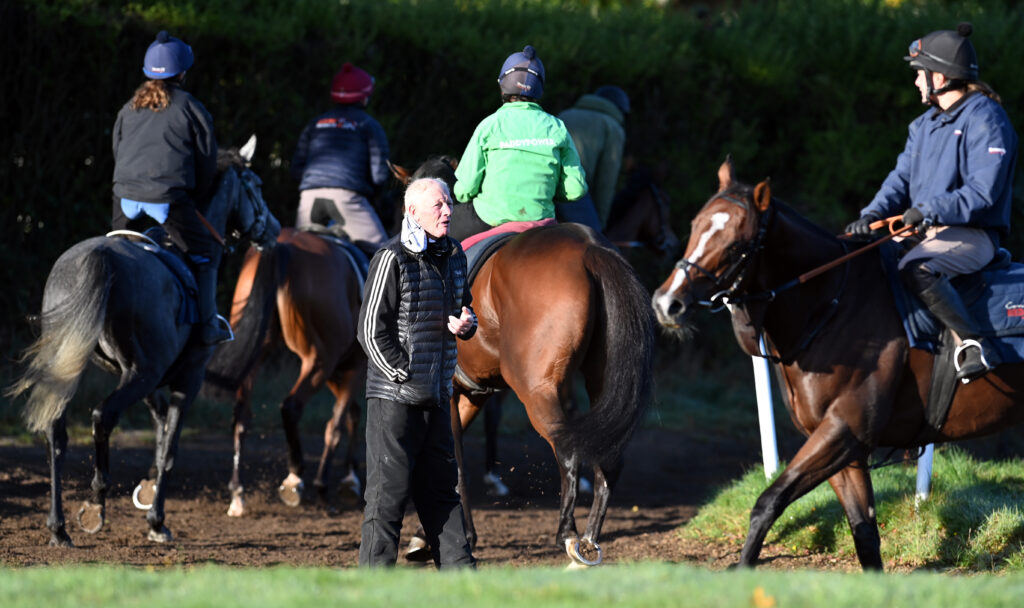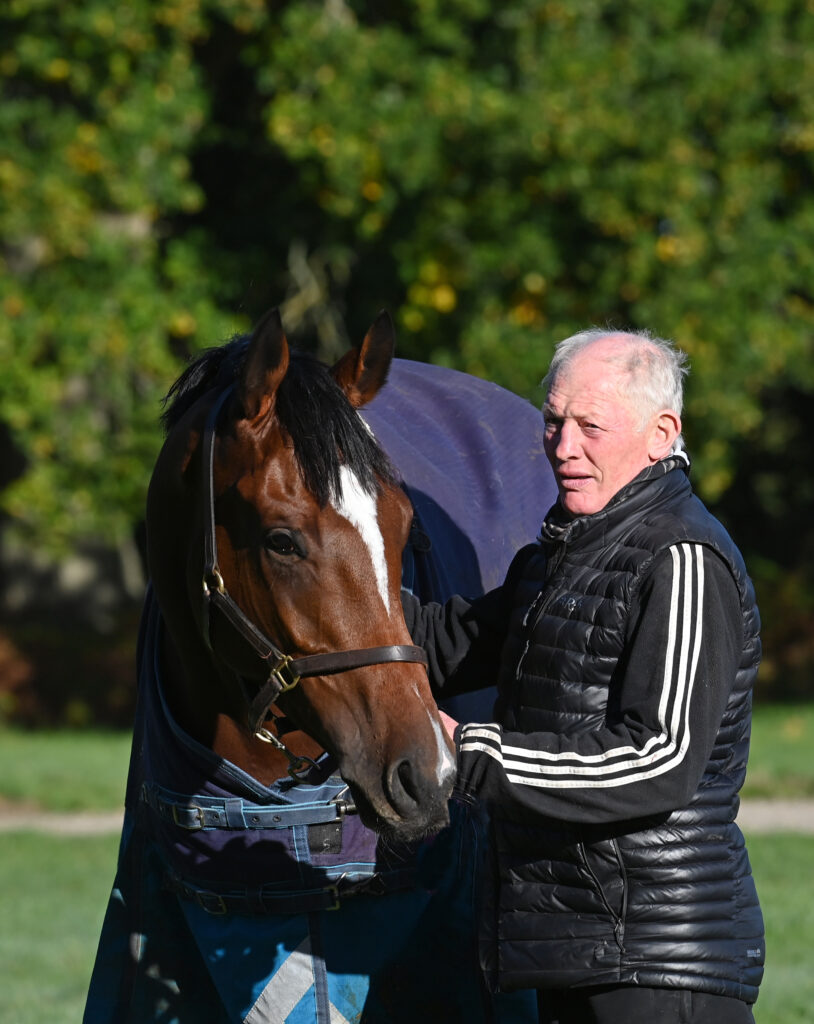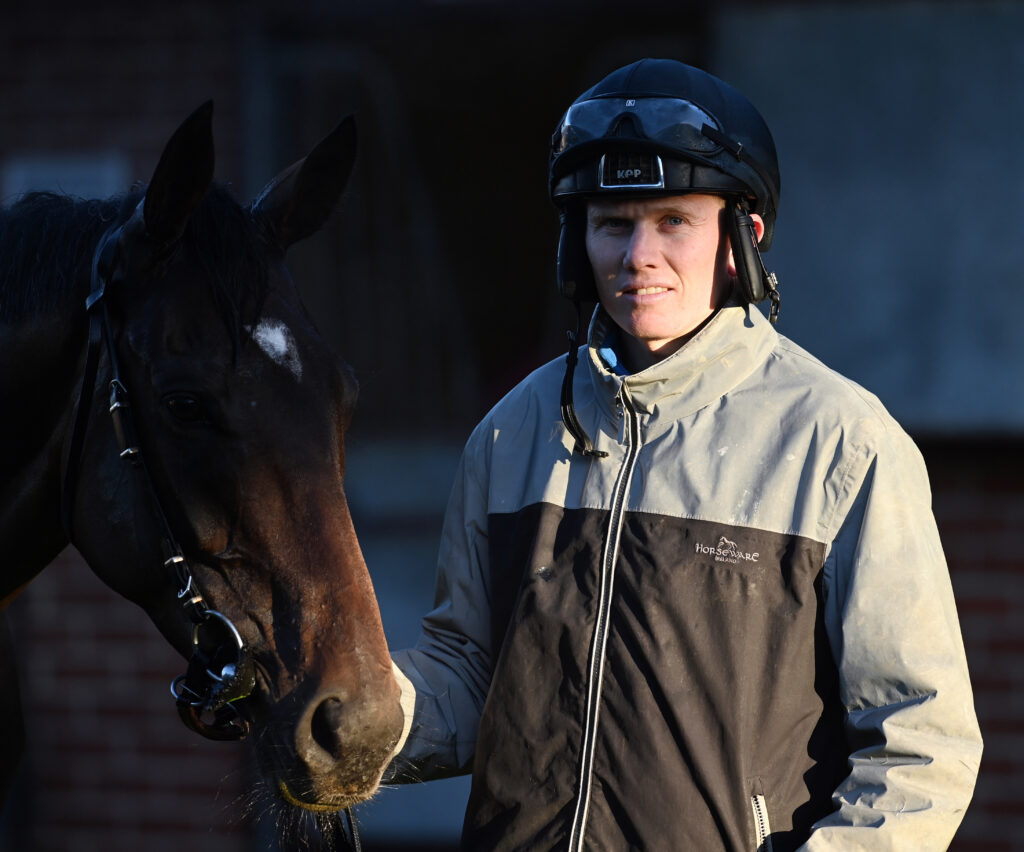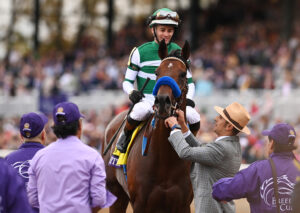The 2021-22 jumps season was Gary Moore’s most successful in his 30 years as a trainer, yielding 91 winners as he broke the £1 million barrier for the first time. At what is proving a difficult time for so many in the industry, his stables are full, as they usually are.
He has long been regarded as one of Britain’s top dual-purpose trainers, perhaps the best of all, and racing is all he has known, having grown up the son of a trainer and gone on to be a hard-as-nails jump jockey before switching to training.
Moore has great owners as well as loyal and hard-working staff, while he probably has better horses than ever at his recently upgraded premises. So why would he be talking about stopping?
The familiar complaints of too much racing, rising costs and excessive red tape all get a good airing in the course of a comfortable hour or so in the office of his Cisswood Racing Stables near Horsham, where wife Jayne joins in from time to time while working away at the computer her husband so actively avoids.
However, such issues have little or nothing to do with Moore’s plans. There is a much, much happier reason for Moore being keen to see his name come off the licence sooner rather than later, and it’s one that the couple could not have dared even contemplate just a few months ago, when the life of their youngest child, the fourth in one of racing’s most famous dynasties, hung in the balance.
“Josh will be taking over here,” confirms Moore, who is not interested in going down the joint licence road favoured by other father-and-son combinations like the Coles, Crisfords and Gosdens.
“It’s a case of when he’s ready,” he adds, “and if he’s not ready I won’t let him. But when the time comes, I’ll just disappear into the background and work for him, like he works for me. I’d say it will definitely be within two years. I hope so anyway!”

Gary Moore, who enjoyed his best ever jumps season in 2021-22, has been training for 30 years | Photo: Bill Selwyn
Moore has no doubt whatsoever that his son, who won a solitary Grade 1 on Ar Mad at Sandown in 2015 but whose horsemanship deserved success on a far greater scale, will be a natural as a trainer, and he can’t wait.
He says: “Training is a young man’s game now and Josh will be absolutely brilliant at it. He’s very switched on and he’s better with staff than I am. He’s a better talker than me too, and owners love him. He’ll get some help too I should think from Ryan, who I hope will get him a few bigger-name owners. Ryan’s input could be unbelievable.
“I’ll stay here and I’ll do anything Josh asks me to do. All I’ll want to do is to work for Josh and do whatever he wants. In a perfect world I’d build a bungalow on the premises where we’ve currently got an aircraft hangar, which I inherited when I took over the place. Josh could then move into our house.”
All that is for the future, although hopefully the not-too-distant future. In the meantime, while he is happy to contemplate taking a back seat, Moore senior is equally at ease reflecting on his time as a trainer and the state of racing.
Moore initially trained in Epsom, first in a property owned by owner Jeff Daniels and then, when he outgrew it, at John Sutcliffe’s former stables, but he also had a lengthy period based at his father Charlie’s former stables close to Brighton racecourse before buying Cisswood from Charles Cyzer.
He explains: “I’ve never regretted buying this place. It’s one of the best things I’ve done in my life. Maybe I should have bought John Sutcliffe’s place when I was training there in the early days, but the trouble with Epsom is it’s too close to London and so prices are extortionate, and also there wasn’t the staff accommodation I’d need.
“We had better horses last season, but also they stayed healthy and sound for longer, and I think they were fitter too”
“We’ve done a lot of work here, building another 60 boxes, changing both gallops over to woodchip, installing a two-and-a-half furlong round canter, putting in an all-weather schooling ground, and more recently adding a deep sand gallop.
“The deep sand gallop is [based] on the Willie Mullins principle, but Willie’s is in a circle and mine’s up a hill. I tried mine in a circle, but it didn’t really work, so we took it up and put woodchip back down, then made a new deep sand gallop up a hill.
“I think we are already seeing the benefits of that from a fitness point of view. You can go slower and over not quite so far, so there’s not so much stress on them, yet you still get the same benefits as they have to work harder in it. We had better horses last season and there was a great team effort behind them, but also they stayed healthy and sound for longer, and I think they were fitter too.”
Attracting owners seldom seems to have been a problem for Moore, who has always been recognised as a trainer who knows the time of day, and he hopes that the cost-of-living crisis will not prove an issue for most of them. Many prefer jumping to the Flat, although that might change when his son takes over.
He says: “If I wanted to and had the staff and the boxes, I could have 150 horses here, but I’m happy with the 110 that I can house. I’m not exactly turning them away though, or at least not often. I’m conscious that there’s more emphasis here now on jumps than the Flat, but I expect that will change when Josh is in charge.
“It’s just happened, rather than there having been any policy change. It’s in large part down to the owners I train for, but also because I’ve had two very, very good jump jockeys working for me, and I felt I had to support them as best I could.
“Also, I find I can compete at a higher level jumping with the sort of horses my owners are prepared to buy than I can on the Flat, where you need Arab owners or EuroMillions winners to buy the ammunition for the top races.
“I’ve got wealthy owners – anybody who has racehorses has got to be quite wealthy in this day and age – and I was able to buy a couple of yearlings at Goffs and had orders for Tattersalls Book 2, but I didn’t even need to think about looking at Book 1 as that’s a completely different level.”
He adds: “I’m lucky to have one owner in particular, Olly Harris, who spends a lot of money on jumpers, and we are seeing the benefits with horses like Porticello, who won the Grade 1 at Chepstow last winter, but there’s not many around like him I’m afraid. He only lives up the road in Esher and he comes down a lot. He’s just the best person to be training for.”

Top-class hurdler Porticello, owned by Olly Harris, is one of the most exciting horses in the stable | Photo: Bill Selwyn
Rising costs, particularly for feed, staff and energy, are a concern for all, and Moore’s weekly rate will almost certainly have to go up before long. “It’s worrying, and some owners may go and look for somewhere cheaper, but I won’t cut any corners,” he says. “I don’t feel I’m over-expensive anyway and if people are doing it for less, they can’t be doing it properly.
“We haven’t got to the stage where we are doing the sums and working out exactly how much costs have gone up, but I can tell you for example that bales of hay – big ones admittedly – are now £130 a time, which is horrendous, and shavings are £9 a bale. I could once probably have bought a ton of hay for what a bale is costing me now, and shavings used to be a fiver a bale.
“The nuts we buy are extortionately priced now too. The war in Ukraine is a big factor, as that’s where the wheat comes from, but we’ve had three price rises in a year. I could find cheaper feed, but as I said, I won’t cut corners. They apologised for the latest price rise and offered us some free merchandise, but horses can’t eat baseball caps, can they?”
Like many, Moore, who masterminded the career of outstanding two-mile chaser Sire De Grugy, winner of five Grade 1s, including the Queen Mother Champion Chase, all under son Jamie, believes that the issues with poor prize-money and falling field sizes are not unconnected.
He says: “There’s obviously too much racing. They keep going on about field sizes, but the solution is so simple that even an idiot like me can work it out. They had a solution but then they didn’t go with it.
“We are going to look at opportunities in France more this winter, but the paperwork for that is horrendous since Brexit”
“Racing dilutes the prize-money so much and there aren’t enough horses to go around, especially on the Flat. We need many fewer meetings, and we shouldn’t be letting the racecourses themselves dictate to us so that they can cash in on the media rights money. It’s got to be greed.”
He continues: “Prize-money is never enough, but that’s not going to change. We are going to look at opportunities in France more this winter, but the paperwork for that is horrendous since Brexit.
“Last season Larry won a £100,000 race at Ascot, which set him up for the season, but generally the prize-money is very poor. Porticello didn’t win a fortune, and even Goshen, who was the best juvenile hurdler of his year, won pitiful amounts.
“Luckily most of my owners are in it for fun. If you are in it for prize-money, you shouldn’t be in it, not in this country anyway. I’ve got a broad spread of them too. It’s no good being too dependent on one owner.”
Red tape, and particularly the need for so much to be done online well in advance that could once have been attended to on course, is among other frustrations. So, too, is the ever-increasing export abroad of so many of the more desirable types at the horses-in-training sales.
But in a year or two it is unlikely to be his problem.
New challenge excites Josh
Josh Moore was surprised when he was sent a renewal notice for his jockey’s licence while he was recovering from his injuries and the subsequent fat embolism that nearly killed him.
He rang the BHA’s Chief Medical Adviser Jerry Hill to ask if he was having a laugh and he was pretty much told not to waste his time and money filling in the form, but he already knew his riding career was over. Accepting the inevitable was not as hard as it might have been.

Josh Moore is looking forward to a new chapter in his life | Photo: Bill Selwyn
Since first riding competitively during the 2007/08 season, Moore has suffered far more injuries than a rider of his style and skill should ever have endured, and so he was prepared for the news.
He knows how lucky he is to simply be alive, let alone fit and well enough again to be able to enjoy being home again with partner Phoebe and two-year-old son Freddie, not to mention looking forward to another exciting stage in his career, even if it is coming rather sooner than he’d have preferred. Almost unbelievably, he is even back riding out two lots a day.
The initial injury was incurred at Haydock in April on Gleno, a yard favourite and a supposedly safe-as-houses jumper. The potentially deadly fat embolism emerged a little later and it was so serious that at times during his three months in hospital the whole of racing, not just his own family, feared the worst.
His recovery has been remarkable and bears testament not only to the skill and care of the medical staff who attended to him in successive institutions, but also to the dogged persistence of his mother Jayne, who read voraciously on the subject and was convinced she recognised a rare condition which even experienced consultants had not previously come across first-hand.
“I’ll miss the riding obviously, but I’ve always planned to train one day and I did the first two trainer modules quite a while ago”
Moore says: “I got lucky. My back is sore still, but otherwise I feel fit and well, although I couldn’t come back race-riding. My back has been opened twice in the last year and my leg was opened too. The fat embolism from the leg injury affected my brain, and although it’s all right now, I’m not sure I’d be able to pass a concussion test again.
“I’ll miss the riding obviously, but I’ve always planned to train one day and I did the first two trainer’s modules quite a while ago, when I was struggling with my shoulders and thought I’d better start thinking about what I’d do next. It’s always been a big interest of mine and I’m booked for the third and last module this month.”
Moore has learned most of what he knows about training from his father – there can be few better from whom to receive an education. However, he has kept his eyes and ears open wherever he has been and will no doubt have a few ideas of his own. How soon he gets to put them into practice remains to be seen, but you can be sure he will be ready when the time comes.
He explains: “I rode out for Jonjo O’Neill for about a year, and more recently for Chris Gordon, and I also used to go down to Emma Lavelle’s when I was a seven-pound claimer. Wherever I’ve been I’ve paid attention to how things are done.”
The younger man agreed with his father that a gradual change in emphasis back in favour of the Flat might be on the cards. “The Flat is of massive interest because in today’s world I think it provides a far better business model to jumpers,” Moore says. “I love jump racing of course, and we have a lot of successful jumps horses, so obviously I’ll want to keep going with them.
“I probably know more about jumping but I do love the Flat and luckily in Ryan I’ve got a brother who knows a lot more about it than I do.”



